
Do you have a question about the NuAire LabGard ES NU-543-300S and is the answer not in the manual?
| Type | Class II, Type A2 Biosafety Cabinet |
|---|---|
| Inflow Velocity | 100 fpm |
| Filter | HEPA |
| HEPA Filter Efficiency | 99.99% at 0.3 microns |
| UV Light | Optional |
| Width | 48 inches |
| Depth | 30 inches |
| Electrical Requirements | 115V, 60Hz |
Describes the LabGard ES Model NU-543S Laminar Flow Biosafety Cabinet (LFBSC) and its function.
Outlines essential safety features and procedures for operating the biosafety cabinet safely.
Explains the meaning of various safety alert symbols used in the manual for hazard identification.
Outlines the steps to take upon receipt if the cabinet has sustained shipping damage.
Specifies ideal placement for the cabinet to ensure optimal performance and safety.
Details the steps for unpacking, assembling, and preparing the cabinet for operation.
Instructions for assembling the optional base stand for the biosafety cabinet.
Describes the process of leveling the cabinet using adjustable leg levelers.
Provides guidance for installing the cabinet on a laboratory bench or casework.
Discusses considerations and safety for gas service connections if required for the application.
Explains connections for plumbing services and recommendations for their use.
Details electrical power requirements and recommended circuit protection.
Covers final checks and preparations before operating the cabinet.
Outlines the procedures and equipment needed for initial cabinet testing and certification.
Details the electronic control system, its functions, and user interface.
Introduces the FlowGard control system and its primary functions for cabinet operation.
Explains the function of each key and LED indicator on the front control panel.
Describes how the cabinet operates when not in active use, including screen saver function.
Details the steps and displays for operating the cabinet in its primary run mode.
Explains how alarms are presented during standby and run modes and their priority.
Guides the user on accessing and navigating the operator main menu for system settings.
Provides essential guidelines for safe and effective use of the biosafety cabinet.
Defines the designated safe work area within the cabinet for performing procedures.
Emphasizes minimizing disruption to the cabinet's airflow barrier for containment.
Advises on reducing room activity to prevent airflow disturbances within the cabinet.
Explains the importance of unidirectional airflow for contaminant control.
Stresses the necessity of aseptic techniques for maximum benefit and safety.
Step-by-step procedures for preparing, performing, and concluding work in the cabinet.
Details the initial steps for powering up and preparing the cabinet for use.
Guides the user on how to conduct procedures safely and effectively within the cabinet.
Describes post-work procedures for purging and disinfecting the cabinet interior.
Discusses ergonomic factors for user health, safety, and efficient cabinet operation.
Provides detailed instructions and recommendations for cleaning the biosafety cabinet.
Offers general advice and considerations for effectively cleaning cabinet surfaces.
Outlines critical procedures for decontaminating the cabinet after exposure to hazardous drugs.
Step-by-step instructions for performing decontamination of the cabinet.
Details methods for decontaminating the cabinet, including manual and automated processes.
Step-by-step guide for performing manual decontamination of the cabinet.
Describes the process and parameters for automated cabinet decontamination.
Instructions for replacing fluorescent or optional LED lamps in the cabinet.
Guides on how to replace HEPA filters and the motor/blower assembly.
Details the steps required to safely remove the supply and exhaust HEPA filters.
Instructions for installing new HEPA filters, reversing the removal steps.
Steps for removing and replacing the motor/blower assembly.
Explains how to adjust the sliding window for proper operation and micro switch function.
Covers the essential procedures for setting up and calibrating the airflow control system.
Details how to configure user and system parameters for optimal performance.
Explains how to establish airflow setpoints and alarm limits for the cabinet.
Provides detailed steps for calibrating the cabinet's airflow system.
Step-by-step guide for calibrating the downflow air velocity.
Step-by-step guide for calibrating the inflow air velocity.
Instructions for adjusting airflow sensor values for accurate readings.
Details how to test the sash alarm function to ensure safety interlocks are active.
Guides on testing airflow and pressure alarms for operational safety.
Covers description, replacement, and fuse management for the main control board.
Explains how to perform a master reset on the FlowGard control board.
Guides on replacing the digital Intelliflow airflow sensor.
A guide correlating error messages with their causes and potential solutions.
Explains how to configure various cabinet functions like UV light and alarms.
Covers settings related to Nite Care, Auto Blower Restart, and password requirements.
Instructions for configuring the cabinet for automated decontamination cycles.
Explains the function and specifications of the fan relay contacts.
Details the function and specifications of the alarm relay contacts.
Covers the functionality, operation, and safety of the optional UV light system.
Step-by-step guide on how to operate the UV light system.
Essential safety precautions to follow when using the UV light.
Guidance on maintaining the UV light, including hour monitoring and cleaning.
Details voltage, frequency, phase, and current ratings for different models.
Advises on chemical compatibility and precautions during cleaning and decontamination.

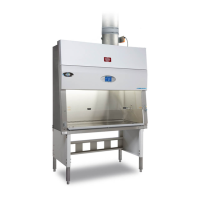
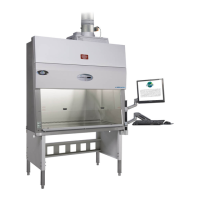
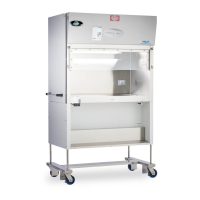
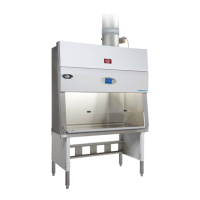
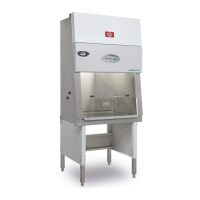
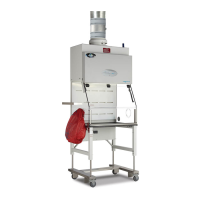
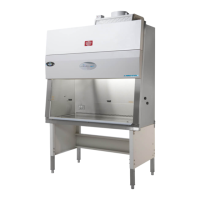

